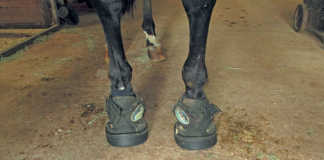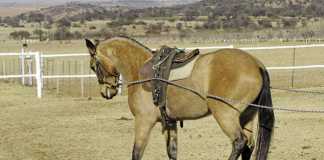Ringworm is the common name for a fungal skin disease contracted by many types of animals, including cattle, horses, donkeys, pigs, camels, goats, dogs, cats, rabbits – and human beings. It’s caused by fungi called dermatophytes. There are two fungal organisms that infect horses, Microsporum and Trichophyton. Microsporum canis fluoresces bright green when examined under ultraviolet light.
Prevention and control
Ringworm can be carried on halters, saddle blankets, horse blankets, girths and bridles, as well as people’s clothes, paddock fences, walls and even water troughs and tree bark. To control an outbreak, all these surfaces must be disinfected with fungus-killing agents (fungicides). Don’t use the same tack on different horses, disinfect halters and bridles routinely, paint wooden paddock poles with creosote and whitewash tree trunks and walls.
Diagnosis
In horses, the hairless, scaly patches caused by ringworm can be mistaken for allergies to biting flies, or grass mange caused by mites. Often the first signs are on the face, exactly where the halter is on a horse, because the disease is usually transferred by using the same halter on different horses. Diagnosis can be made by skin scrapings, biopsy of the skin (a small piece of skin is removed surgically and sent to a pathologist), or cultures made from samples of affected hair.
Treating ringworm
There are several different treatments available. But it’s best to start by shampooing the whole horse with a fungicidal shampoo to remove the dead hair and dandruff that protects the fungus. Iodine-based shampoos are effective, but some horses show an allergic reaction to iodine. An antimicrobial handwash called F10 has been used as a fungicidal shampoo for pets and should be effective on horses too.
Thereafter you should rinse the whole horse with a fungicidal solution twice weekly for up to three weeks to remove fungal spores from the coat and prevent re-infection. It’s important to persevere with the treatment even though the lesions may look worse at first, as the infected hairs fall out when the fungus is killed. Sponging down or spraying with lime sulphate has been suggested for many years.
This solution is commonly used to destroy fungi on rose bushes and can be very irritating to the skin. Dilute 20mâ„“ of lime to 5â„“ of water and take care to avoid getting the mixture into the horse’s eyes.Spot treatment can be used on hairless spots, particularly on the face. Gentian violet is fungicidal, as is Merthiolate, and there are a number of mercury-based ointments available to treat the hairless spots. Ringworm ointment is an anti-fungal mixture available at most tack shops.
Follow the directions carefully and wear gloves when applying the ointment.Strict safety measures, such as washing hands with fungicidal soap, protective clothing for handlers (gumboots and overalls must be washed every day) and keeping infected horses away from other animals and people, must be followed. Feed and water containers, and stable walls and doors, must be wiped down with a solution of household bleach (30ml/â„“) to remove fungal spores. Remove all bedding and manure daily from infected horses’s stables.
Ringworm in humans
In humans, ringworm is first seen as a small, round, red mark on the skin. This becomes scaly around the edges or in the centre and may be itchy and spread further. It’s very infectious for other humans or animals, and a doctor must be consulted as soon as possible. It’s easily cured and often those who have contracted it won’t get it again.
Contact Dr Mac c/o Chris Nel at [email protected].













